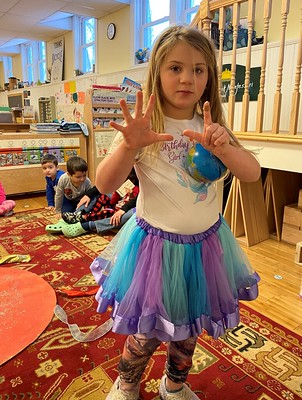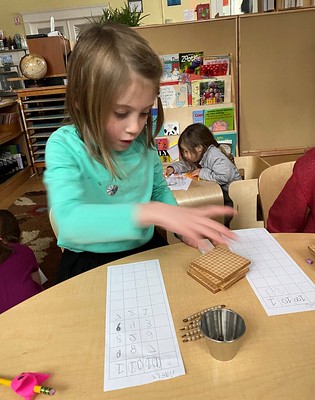Snow is a wondrous thing! It can show you how to get to a deer yard when wandering through the woods or let you follow a winding snowshoe hare trail or see where mice have popped up to run around. We read about animals leaving tracks on their way home one winter night and used our previous knowledge and experiences and the pictures in the book to figure out which animals were heading home. For art the children stamped, traced, or drew animal tracks on a snowy white paper and used track cards to identify them.
We celebrated a 7th birthday on our first day back with tasty cupcakes. The birthday girl informed us she was born in the month of December in late fall seven years ago. She went so quickly around the sun it was hard to keep up with listing the seasons and counting the seven years, so we probably tacked on a few extra with all that orbiting!
During sign language Rose introduced signs that have to do with mammals, including hair, deer, moose, squirrel, and bear. She then read the story Duck, Duck, Moose by Sandra Boynton about some ducks who make a cake and Moose who messes it up but is forgiven when he realizes what he has done.
We introduced mammals through some songs, games, and exploration. Each of the children selected a mammal from the animal bin and shared their observations about it. They all had 4 limbs and hair. We ran our hands down our backs to feel our vertebrae and looked at a model of a spinal column. We learned that mammals are vertebrates with bones and a spine. We learned that baby mammals are born alive and drink milk from their mothers, which is where the name mammal comes from; the mammary glands that female mammals have for producing milk.
The children really enjoyed spending some time examining the bones from a fox skeleton Lyn and her children found while walking through the woods a few summers ago that they collected and cleaned. It was almost the entire skeleton, skull to tail, including the toe bones and claws. They very carefully rolled out mats and spent time gently removing the different sets of bones and looking at them, the skull and teeth, shoulder blades and pelvis, vertebrae, leg bones, ribs, toes, and claws.
The Day the Crayons Quit by Drew Daywalt preceded a conversation about disappointment and handling and managing those feelings when something happens that is disappointing. The children shared experiences when they were disappointed, such as when a block structure or sandcastle got ruined, or they couldn’t watch a show when they wanted to, or had to wait until the weekend for hot chocolate, or they really wanted something but couldn’t have it, etc. We all shared some things we could do to manage that disappointment, such as rebuilding the structure, having a conversation about it, taking some breaths and letting it go, figuring out a way to do it differently next time, or changing the narrative in our heads from negative thoughts to positive thoughts, such as “it really stinks that we have to leave the beach so I don’t have time to rebuild that castle, but I know I will get to come to a beach again and I will build another one.” or “At least I have hot chocolate to look forward to this weekend!”
Since humans are mammals, we will also be studying the human body and how to take care of it. We spent some time building and painting an ambulance and took Friday morning to set up a health clinic in dramatic play. The physicians, nurses, and office managers were anxious to get to work signing in, examining, and treating patients, and the patients were ready for their appointments.
Kindergarten students spent the week on math. They were introduced to the ten bead bars and did some work counting by tens and building 10’s numbers. The numbers 10, 20, 30, 40, 50, 60, 70, 80, and 90 were flipped over and the children selected one, flipped it over, and built it using their ten beads. They were then introduced to the 100 square and did the same thing, building 100’s. Finally they were given sets of unit beads, 10 bead bars, and 100 squares then used place value charts to record the number they had, counting up each set and writing the corresponding number in the correct place value spot.

































































